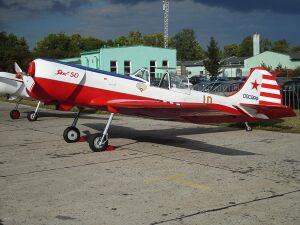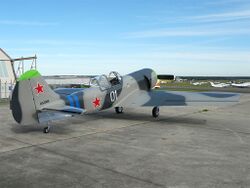Engineering:Yakovlev Yak-50 (1975)
| Yak-50 | |
|---|---|

| |
| Role | Trainer/aerobatic aircraft |
| Manufacturer | Yakovlev |
| First flight | 25 June 1975 |
| Produced | 1975-1986 |
| Number built | 314 |
| Developed from | Yakovlev Yak-18 |
| Variants | Yakovlev Yak-52 |
The Yakovlev Yak-50 (Russian: Яковлев Як-50) aerobatic aircraft is a single-seat all-metal low-wing monoplane with retractable main wheels and exposed tail wheel. The control surfaces are fabric-covered to save weight. The aircraft is not equipped with flaps.
The supercharged engine may be the Vedeneyev M14P (standard production line version), M14PF or M14R, producing between 360 and 450 hp and driving the propeller via a reduction gearbox. The landing gear, brakes and engine starter are operated by compressed air. Replenished by an engine-driven compressor, the main and emergency air bottles are contained within the forward fuselage between the firewall and fuel tanks.
The Yak-50 has fine handling characteristics[citation needed] enhanced by a relatively high power-to-weight ratio. It has a tough and agile airframe - the type was twice World Aerobatic Champion. It has been used as a military trainer by several countries.
Aircraft serving with the Soviet National Aerobatic team were typically scrapped after about 50 flight hours, due to the intense stresses imposed on the airframe during unlimited aerobatics. There were numerous cases of main spar failure; among its victims were the 1976 World Aerobatic Champion Viktor Letsko and many others.
Two modifications (Service Bulletin 61DA for S/N 0102-2007 and Service Bulletin 79 for S/N 1201-2806) were made to strengthen the wings spars for the extreme loads experienced during unlimited aerobatics, and no further failures occurred.[citation needed]
Other aircraft serving with DOSAAF were "officially" scrapped or placed into storage after they were superseded by the Yak-55 and Su-26.
It is these aircraft that form the bulk of airworthy "survivors" today.[1] Only a few (approx. 90+) are airworthy and remain in private hands in Europe, the USA, Australia and Canada.
Operators
 Lithuania
Lithuania
- Lithuanian National Defence Volunteer Forces - Ex DOSAAF aircraft
 Russia
Russia
- DOSAAF Russia
 Ukraine
Ukraine
- DOSAAF Ukraine
 Soviet Union
Soviet Union
- DOSAAF
Specifications
General characteristics
- Crew: 1
- Length: 7.8 m (25 ft 7 in)
- Wingspan: 9.5 m (31 ft 2 in)
- Height: 3.2 m (10 ft 6 in)
- Wing area: 15 m2 (160 sq ft)
- Airfoil: root: Clark YH (14.5%) ; tip: Clark YH (9.3%)[2]
- Empty weight: 750 kg (1,653 lb)
- Max takeoff weight: 910 kg (2,006 lb)
- Powerplant: 1 × Vedeneyev M-14P 9-cylinder air-cooled radial piston engine, 269 kW (361 hp)
- or 298 kW (400 hp) M-14PF or 336 kW (451 hp) M-14R
- Propellers: 2-bladed constant-speed propeller
Performance
- Maximum speed: 400 km/h (250 mph, 220 kn) (VA)
- Cruise speed: 270 km/h (170 mph, 150 kn) (VNO)
- Stall speed: 100 km/h (62 mph, 54 kn)
- Take-off speed: 130 km/h (81 mph; 70 kn)
- Landing speed: 110 km/h (68 mph; 59 kn)
- Never exceed speed: 450 km/h (280 mph, 240 kn) (VNE)
- Range: 500 km (310 mi, 270 nmi)
- Service ceiling: 4,000 m (13,000 ft)
- g limits: +9 -6 (dependent on tankage and smoke oil installation)
- Rate of climb: 11.3 m/s (2,220 ft/min) at max continuous power at MTOW
- 16 m/s (52 ft/s) at take-off power
- Wing loading: 60.7 kg/m2 (12.4 lb/sq ft)
- Power/mass: 0.295 kW/kg (0.179 hp/lb)
- Take-off run: 100 m (328 ft)
- Landing run: 250 m (820 ft)
References
 |



